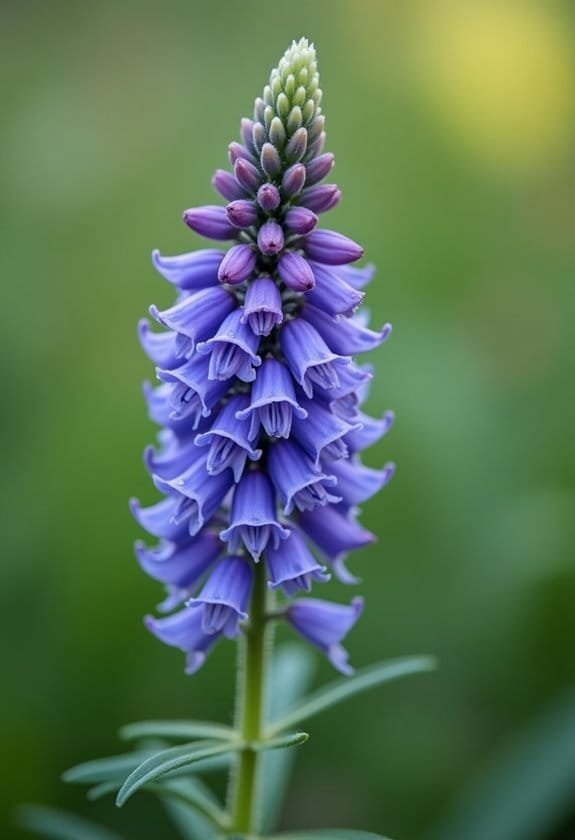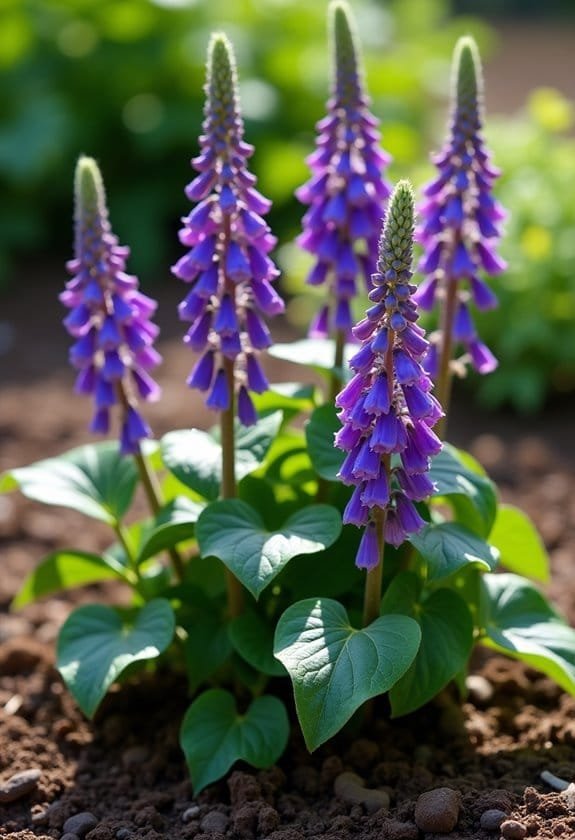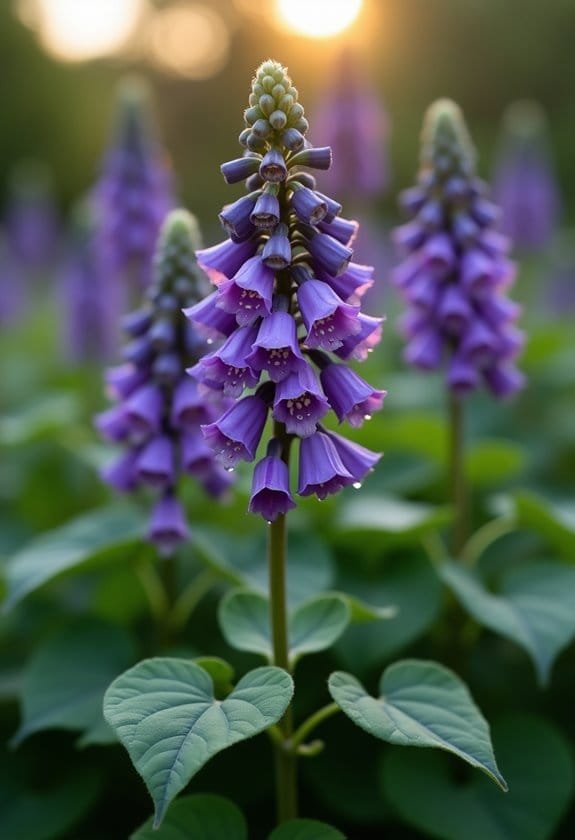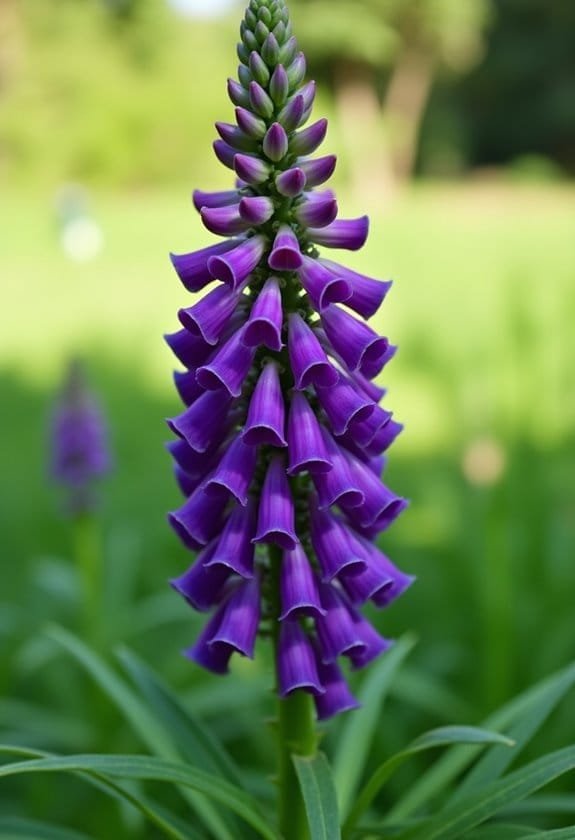Campanula glomerata stands out as a resilient perennial, featuring dense clusters of violet-blue to white bell-shaped blooms that crown sturdy stems reaching 6 to 24 inches tall. Native to Europe and western Asia, this adaptable plant thrives in USDA zones 3-8, preferring well-drained soils with neutral to slightly alkaline pH levels. It's a pollinator powerhouse, attracting bees, butterflies, and hummingbirds during its peak flowering period from May through July. While its clump-forming, rhizomatous growth pattern requires strategic management, the Clustered Bellflower's commanding presence and ecological benefits make it an exceptional choice for those seeking a garden showpiece that supports local biodiversity.
Main Points
- Campanula glomerata is a perennial flowering plant featuring dense clusters of violet-blue to white bell-shaped blooms atop 6-24 inch stems.
- Native to Europe and Asia, this hardy plant thrives in USDA zones 3-8 and prefers well-drained soil with full sun to partial shade.
- The plant blooms from May through July, attracting pollinators like bees, butterflies, and hummingbirds with its nectar-rich flowers.
- Regular maintenance includes deadheading spent blooms, dividing clumps every 3-5 years, and monitoring for slug damage and fungal diseases.
- Its rhizomatous growth habit allows for steady colonization, forming attractive clumps that can spread 12-36 inches wide.
Introduction

Campanula glomerata, commonly known as Clustered Bellflower, stands as a striking perennial that graces gardens with its distinctive bell-shaped blooms.
The plant's scientific nomenclature reflects its growth habit, with 'glomerata' referring to the tightly clustered flowers that appear in dense heads atop sturdy stems.
Native to Europe and western Asia, this versatile herbaceous perennial has captivated gardeners worldwide with its upright growth pattern, reaching heights of 6 to 24 inches, and its remarkable ability to attract beneficial pollinators to any garden setting.
Common Name
Several common names identify Campanula glomerata, with Bellflower and Clustered Bellflower being the most widely recognized. The name "Danes Blood" is also attributed to this remarkable plant, which graces meadows and rocky slopes across Europe and western Asia with its distinctive presence.
The scientific name itself carries significant meaning, as "Campanula" derives from Latin, translating to "small bell," an apt description of the plant's charming blooms. When pronounced "kam-PAN-yoo-lah glo-mer-AY-tah," the name reflects both its taxonomic classification and its defining characteristics.
The species designation "glomerata" specifically refers to the plant's most striking feature: its dense clusters of flowers, which can showcase up to 15 blooms on a single stem. These compact flower arrangements have earned it the widely-used common name "Clustered Bellflower," perfectly describing its growth pattern.
The bell-shaped flowers grow in such tight formations that they create impressive visual displays in gardens and natural settings, making this plant instantly recognizable to both casual gardeners and botanical enthusiasts alike.
Scientific Name
The formal scientific designation places this elegant plant firmly within the botanical classification system. Known scientifically as Campanula glomerata, this perennial herbaceous plant carries a name that beautifully describes its distinctive characteristics. The genus name "Campanula" derives from Latin, meaning "small bell," which perfectly captures the shape of its charming flowers.
The specific epithet "glomerata" provides additional insight into the plant's nature, referring to its habit of producing tightly clustered flower formations. As a distinguished member of the Campanulaceae family, Campanula glomerata showcases its heritage through clusters of up to 15 violet-blue to white bell-shaped flowers.
This scientific classification helps botanists and gardeners understand its relationship to other bellflowers while confirming its native range across Europe and western Asia. The plant's remarkable adaptability, evident in its success across USDA zones 3-8, demonstrates why scientific classification is vital for understanding growth patterns and cultivation requirements.
This systematic naming convention enables researchers and horticulturists to precisely identify and study the Clustered Bellflower's characteristics and behaviors across different regions.
Overview
Among the most enchanting perennial plants in European gardens, Clustered Bellflower stands out for its striking clusters of bell-shaped blooms and adaptable nature. This hardy perennial, scientifically known as Campanula glomerata, flourishes across diverse landscapes from meadows to woodland edges, showcasing its remarkable versatility in both natural and cultivated settings.
Rising gracefully to heights between 6 and 24 inches, Campanula glomerata produces spectacular violet-blue to white flowers that cluster together in groups of up to 15 blooms. The plant's resilience is evident in its ability to thrive in USDA zones 3-8, adapting to various light conditions from full sun to partial shade.
Its preference for well-drained, neutral to slightly alkaline soils makes it a reliable choice for diverse garden designs.
Beyond its ornamental appeal, Clustered Bellflower serves as a crucial resource for local ecosystems, attracting essential pollinators including bees, butterflies, and hummingbirds.
The plant's self-seeding characteristic enables it to establish lasting colonies, making it an excellent choice for naturalized gardens and ground cover applications where sustainable growth is desired.
Key Features
Campanula glomerata stands out in gardens with its impressive clusters of bell-shaped blooms, which appear in dense formations of up to 15 flowers per stem in violet-blue or white hues.
The plant's moderate growth pattern, reaching heights between 6 and 24 inches with a spread of 12 to 36 inches, makes it particularly suitable for mid-border garden arrangements.
Its ovate to lance-shaped foliage creates a lush backdrop throughout the growing season, while the plant's self-seeding nature guarantees sustained presence in favorable conditions.
Growth Size
Standing at a mature height of 6-24 inches (15-60 cm), clustered bellflowers spread into impressive clumps spanning 12-36 inches (30-90 cm) wide. This moderate size makes Campanula glomerata an ideal choice for mid-border garden placements, where its striking profile can complement both taller background plants and shorter front-row specimens.
The plant's growth habit is distinctly clump-forming, with robust stems rising from a gradually expanding base. Through its rhizomatous growth pattern, each established plant steadily colonizes its surroundings, creating dense clusters that showcase both foliage and flowers.
The ovate to lance-shaped leaves form attractive rosettes along the stems, contributing to the plant's architectural presence in the garden.
This hardy perennial demonstrates remarkable adaptability across USDA zones 3-8, making it suitable for diverse climate conditions. Its compact yet spreading nature allows gardeners to achieve substantial coverage without overwhelming neighboring plants, while its manageable height guarantees it maintains proper scale within designed landscapes.
The plant's measured growth rate strikes an ideal balance between vigorous expansion and controlled spread.
Appearance
With its striking violet-blue to white bell-shaped blooms, Clustered Bellflower creates a stunning visual display during its peak flowering season from May through July. Each Campanula glomerata flower measures approximately one inch across, clustering together in impressive groups of up to 15 blooms per stem.
The plant's sturdy erect growth contributes substantially to its commanding presence in garden settings, where its architectural form stands as a proof of nature's precise design. Dense ovate lance-shaped leaves provide a robust foundation for the flower clusters, creating an aesthetically pleasing balance between foliage and blooms.
The Royal Horticultural Society has recognized the plant's exceptional visual impact through various awards, acknowledging its outstanding ornamental value.
The Clustered Bellflower's appearance embodies a perfect harmony of form and function, with its upright stems rising confidently through border plantings. Its bell-shaped flowers, reminiscent of tiny musical instruments, dance in gentle breezes while maintaining their structural integrity.
This combination of delicate beauty and sturdy constitution makes Campanula glomerata an invaluable addition to any carefully curated garden design.
Flowering Season
Peak flowering season transforms Clustered Bellflower into a spectacular display of color from May through July. During this vibrant period, Campanula glomerata produces an abundance of bell-shaped flowers that cluster together in spherical formations at the terminal ends of each stem, creating a mesmerizing visual impact in gardens and natural settings.
The flowering pattern showcases up to 15 individual blooms per stem, with each flower measuring between 1 to 3 inches, supported by sturdy leafy stems that maintain their upright position throughout the blooming period.
The predominant violet-blue hue of these flowers makes them particularly striking, though specialized cultivars like Schneekrone offer variations with pristine white petals. As the plants reach their peak flowering time, they become increasingly valuable for both ornamental garden displays and floral arrangements, where their dense clusters create focal points of intense color.
The extended blooming period, lasting through the height of summer, guarantees that gardens maintain their visual appeal during the most active growing months, while providing consistent materials for cut flower enthusiasts.
Growing Requirements

Campanula glomerata showcases remarkable adaptability in its growing requirements, thriving in both full sun and partial shade while preferring well-drained soil with a pH between 6.0 and 8.0.
The plant's success depends on maintaining consistent moisture levels without waterlogging, as excessive water can lead to root deterioration and compromise its health.
These hardy perennials flourish in USDA zones 3-8, demonstrating their resilience across varied climates, though they benefit from protective mulching in regions where winter temperatures plunge below freezing.
Light
The ideal growing conditions for Campanula glomerata center on its light requirements, which range from full sun to partial shade. In warmer climates, positioning the plant in areas that receive morning sun and afternoon shade helps prevent stress and maintains peak growth patterns throughout the growing season.
While Campanula glomerata demonstrates remarkable adaptability to various light conditions, consistent sunlight exposure plays an essential role in promoting vigorous flowering and maintaining the plant's characteristic compact growth habit. When provided with proper light conditions, these perennials can reach impressive heights of 6 to 24 inches, making them excellent choices for mid-border areas in garden designs.
The plant's light requirements directly influence its self-seeding nature, as adequate sunlight exposure encourages robust seed production and natural garden expansion.
To maximize the plant's potential, gardeners should combine appropriate light conditions with well-drained soil, avoiding heavy clay or waterlogged areas that could compromise root health. This careful balance of light and soil conditions guarantees the plant maintains its striking appearance while fulfilling its role as a reliable garden performer.
Soil
While proper light conditions support healthy growth, soil composition forms the foundation of successful Campanula glomerata cultivation. This resilient perennial thrives in well-drained soils with a neutral to slightly alkaline pH range of 6.0-8.0, which provides the ideal chemical balance for nutrient absorption and root development.
The plant's relationship with soil moisture proves particularly significant, as it demands a delicate balance between adequate hydration and proper drainage. Regular watering maintains consistent moisture levels, yet gardeners must vigilantly avoid waterlogged conditions that can trigger devastating root rot.
In rich, fertile soils, Campanula glomerata demonstrates its vigorous nature by spreading rapidly to establish extensive colonies, making soil quality management essential for controlling its growth patterns.
Hardy in USDA zones 3-8, this adaptable species showcases remarkable versatility across different soil conditions, though it expressly resists heavy clay compositions. Gardeners should amend dense soils with organic matter to improve drainage and maintain the plant's preferred soil structure, ensuring the robust root system can effectively support its distinctive clustered blooms.
Water
Maintaining proper water levels stands fundamental for Campanula glomerata's sustained health, with regular watering necessary to keep soil consistently moist but not waterlogged. Establishing a balanced irrigation schedule helps prevent both drought stress and excessive moisture accumulation, which can contribute to detrimental root rot conditions.
After initial planting, thorough watering becomes essential to support root establishment and promote vigorous growth patterns throughout the growing season. During particularly challenging dry spells or heat waves, gardeners should increase watering frequency to maintain ideal soil moisture levels, ensuring the plant's continued vitality and flowering potential.
Implementing a strategic mulching approach around the plant's base serves multiple purposes in water management. A 2-3 inch layer of organic mulch helps regulate soil moisture retention, reducing water evaporation while simultaneously suppressing competitive weed growth.
This protective barrier proves especially beneficial during periods of environmental stress, when consistent moisture levels become critical for sustaining the plant's health and maintaining its characteristic clustered blooms.
Temperature
Beyond water management considerations, temperature requirements play a key role in Campanula glomerata's successful cultivation. This resilient perennial demonstrates remarkable adaptability across USDA hardiness zones 3-8, thriving in regions that experience both frigid winters and warm summer conditions. The plant's temperature tolerance allows it to establish robust growth patterns throughout diverse seasonal changes.
In warmer climates, Campanula glomerata benefits from strategic placement in areas that receive part shade, particularly during intense afternoon sun, which helps prevent heat stress and maintains ideal growing conditions.
While the plant exhibits strong cold tolerance, its relationship with temperature intertwines closely with soil and moisture requirements, as well-drained soils become especially essential during temperature fluctuations. The plant's ability to withstand varying temperatures depends greatly on proper soil conditions and moisture levels.
During peak summer conditions, when temperatures rise markedly, these bellflowers maintain their vigor through a combination of adequate moisture and appropriate light exposure, whether in full sun or part shade settings, demonstrating their remarkable environmental adaptability.
Pollinator Criteria
Campanula glomerata serves as a crucial pollinator hub, attracting diverse visitors including bees, butterflies, and hummingbirds with its densely packed, bell-shaped blooms.
The plant's abundant nectar and pollen resources, concentrated in clusters of up to 15 flowers per stem, make it particularly appealing to specialized pollinators such as the Plasterer bee (Colletes brevicornis).
These interactions between Campanula glomerata and its pollinators contribute greatly to local biodiversity, as the plant's extended blooming period from May through July aligns perfectly with peak pollinator activity seasons.
Attracted Pollinators
Through its vibrant bell-shaped flowers, Clustered Bellflower serves as a vital nectar source for various pollinators, including bees, butterflies, and hummingbirds.
During its peak flowering period from May to July, Campanula glomerata becomes a bustling hub of pollinator activity, offering sustenance when many other plants haven't yet bloomed.
The plant's architectural design proves particularly advantageous for pollination efficiency, as each stem supports up to 15 densely clustered blooms that create natural landing platforms for visiting insects.
This arrangement allows pollinators to move efficiently between flowers, maximizing their nectar collection while facilitating cross-pollination.
The native Plasterer bee (Colletes brevicornis) demonstrates a special affinity for these flowers, relying heavily on their nectar for survival.
Pollination Method
During pollination, the bell-shaped blooms of Clustered Bellflower employ specific criteria that determine successful reproduction. The Campanula glomerata's tubular flowers serve as sophisticated feeding stations, providing an ideal landing platform for visiting pollinators while guaranteeing effective pollen transfer.
Cross-pollination forms the cornerstone of this plant's reproductive strategy, with its clustered arrangement of flowers acting as a beacon for pollinators. The strategic blooming period, extending from May through July, synchronizes perfectly with peak pollinator activity, maximizing reproductive success.
Each flower's structure has evolved to accommodate various pollinator species, from nimble bees to hovering hummingbirds.
The plant's abundant nectar production serves as a crucial energy source for pollinators, creating a mutually beneficial relationship that supports ecosystem health.
This sophisticated pollination system relies on the precise timing of nectar production and the strategic positioning of reproductive organs within the bell-shaped flowers. The result is a highly efficient cross-pollination mechanism that guarantees genetic diversity while contributing to the broader ecological community's sustainability.
Care & Maintenance

Successful cultivation of Campanula glomerata begins with selecting a well-drained planting site that offers neutral to slightly alkaline soil conditions and consistent moisture without water-logging.
Regular maintenance tasks include deadheading spent blooms to encourage reblooming, monitoring for slug damage, and implementing proper spacing to guarantee adequate air circulation between plants.
The clustered bellflower thrives alongside complementary perennials that share similar soil and moisture requirements, making it an excellent companion for plants like Geranium and Salvia varieties.
Planting Tips
Campanula glomerata's care requirements make it a relatively low-maintenance perennial for most gardens. When selecting a planting location, gardeners should prioritize sites that receive full sun, particularly in cooler regions where ideal growth depends on maximum light exposure.
The soil should be well-drained and fall within a pH range of 6.0 to 8.0, making it suitable for both neutral and alkaline conditions. During the initial planting phase, maintain consistent moisture levels without creating waterlogged conditions that could harm the root system.
A layer of organic mulch serves dual purposes: moisture retention and weed suppression. Space plants appropriately to guarantee adequate air circulation, which helps prevent fungal issues in this otherwise disease-resistant species.
While Campanula glomerata demonstrates strong resilience against most garden challenges, vigilance against slugs and snails remains important during establishment. To promote long-term vigor, implement a division schedule every 3 to 5 years, preventing overcrowding and maintaining healthy growth patterns.
Regular pruning after flowering not only encourages additional blooming cycles but also controls the plant's natural tendency to self-seed, helping maintain its intended garden footprint.
Ongoing Care
Regular maintenance tasks keep Campanula glomerata thriving throughout its growing season. The most vital ongoing care practice involves cutting back stems after blooming, which not only prevents unwanted self-seeding but also encourages a potential second flush of vibrant flowers.
To maintain the plant's vigor and prevent overcrowding, gardeners should divide clumps every three to five years, a practice that guarantees ideal growth and abundant flowering.
Applying mulch around the base serves multiple purposes, including moisture conservation, weed suppression, and temperature regulation for healthier root development.
While Campanula glomerata is remarkably disease-resistant and low-maintenance, vigilant monitoring for pests like slugs and snails remains critical for plant health. Proper air circulation helps prevent fungal issues, making strategic spacing between plants particularly important.
Though not strictly necessary, an early spring fertilization can provide an extra boost to growth and flowering performance. These care practices, when implemented consistently, create an environment where these clustered bellflowers can flourish with minimal intervention, rewarding gardeners with reliable, long-lasting blooms.
Suggested Companions
In gardens, thoughtful companion planting enhances both the health and visual appeal of Campanula glomerata. When paired with ornamental grasses, these clustered bellflowers create a stunning interplay of textures, as the grasses' feathery movements contrast beautifully with the flower's rigid stalks.
The violet-blue blooms of Campanula glomerata harmonize exceptionally well with flowering plants like Salvia species and Geranium varieties, creating a tapestry of color diversity that attracts beneficial pollinators to the garden.
Lady's mantle serves as an essential companion, its low-growing foliage helping retain soil moisture while naturally suppressing unwanted weed growth around the bellflower's base.
For maximum impact, incorporating Coreopsis varieties alongside Campanula glomerata produces a vibrant display where golden yellows complement deep purples.
This thoughtful combination of companion plants contributes to a visually appealing landscape that maintains interest throughout the growing season.
When properly grouped, these plant partnerships not only enhance the garden's aesthetic value but also create a balanced ecosystem where each species supports the others' growth and well-being.
Common Issues
Campanula glomerata faces several challenges that can impact its health and appearance, with slugs and snails being primary culprits that feed on its tender foliage and flowers.
In humid conditions, these plants become particularly susceptible to fungal diseases, which can manifest as leaf spots and stem rot when air circulation is poor.
While these issues can seem intimidating, implementing proper spacing between plants, maintaining good garden hygiene, and applying organic pest control methods can effectively manage most problems that arise.
Pests/Diseases
While generally hardy and disease-resistant, Campanula glomerata can face challenges from specific pests and diseases that gardeners should monitor. The most persistent threats come from slugs and snails, which can systematically devour leaves and flowers, leaving behind distinctive holes and slimy trails that signal their presence.
Though the plant maintains its reputation as a low-maintenance perennial, vigilant observation remains essential for maintaining ideal plant health.
In environments with excessive moisture, fungal diseases can emerge as a significant concern for clustered bellflower populations. Gardeners can effectively minimize these risks by ensuring proper air circulation around the plants and implementing strategic spacing to prevent overcrowding.
The key to disease prevention lies in maintaining well-drained soil conditions, which create an inhospitable environment for harmful pathogens. Regular inspection of the foliage for early warning signs, such as discoloration or unusual spotting, allows for prompt intervention before problems escalate.
Despite these potential challenges, Campanula glomerata's natural resilience typically prevails when basic preventative measures are consistently applied.
Solutions
Gardeners can effectively address common issues with Campanula glomerata through several targeted solutions. Managing this plant's invasive tendencies requires regular monitoring and implementation of specific control measures, particularly in areas with moist soil conditions where rhizomatous spread is most aggressive.
To maintain healthy growth patterns, implementing a consistent deadheading regimen proves vital, as it not only prevents unwanted self-seeding but also promotes additional blooming cycles throughout the growing season.
Division of established clumps every 3 to 5 years serves as an essential maintenance strategy, preventing overcrowding while rejuvenating the plant's vigor and overall health.
For pest management, particularly against slugs and snails, improving air circulation and reducing excess moisture creates an environment less conducive to these unwanted visitors.
The key to preventing root rot lies in ensuring proper soil drainage, which can be achieved by incorporating organic matter and maintaining consistent, but not excessive, moisture levels.
These preventive measures, when implemented systematically, help maintain Campanula glomerata's ideal growth while minimizing potential issues that could compromise its ornamental value.
Summary

This stunning perennial flowering plant features clusters of violet-blue to white bell-shaped blooms that grace gardens from May to July. Campanula glomerata, commonly known as the Clustered Bellflower, stands as a tribute to nature's architectural brilliance, reaching heights of 6-24 inches while spreading gracefully across 12-36 inches of garden space.
Native to Europe and western Asia, this hardy species has adapted to thrive in diverse environments, from meadow landscapes to woodland margins. The plant's versatility shines through its ability to flourish in both full sun and partial shade conditions, particularly in well-drained soils with neutral to slightly alkaline properties.
Its low maintenance requirements, combined with its USDA zone 3-8 hardiness, make it an excellent choice for gardeners seeking reliable perennial beauty.
Beyond its ornamental value, the Clustered Bellflower serves as an essential resource for pollinators, attracting bees, butterflies, and hummingbirds with its nectar-rich flowers. This ecological significance, paired with its stunning visual display, establishes Campanula glomerata as a valuable addition to any garden setting.


